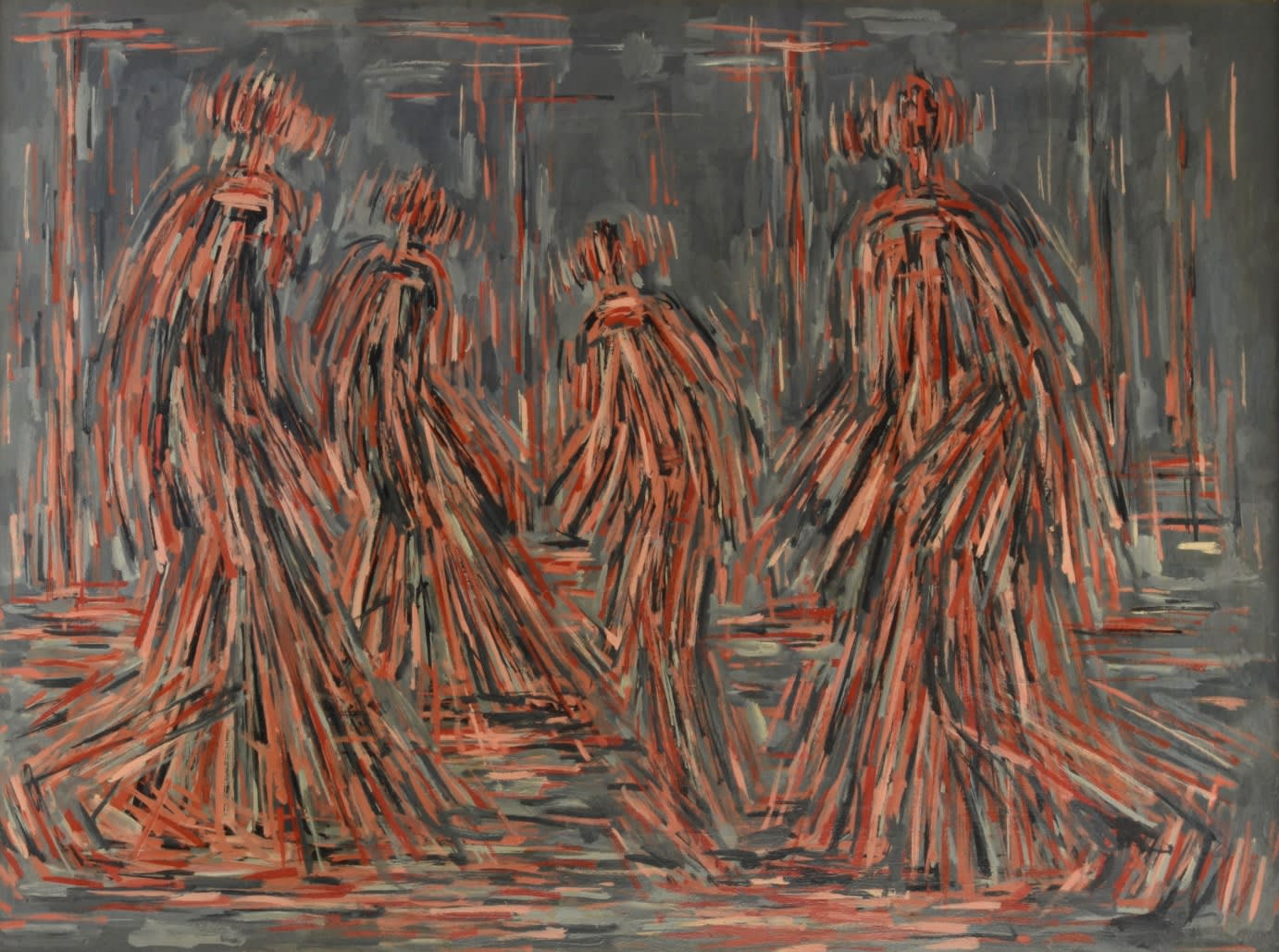William Turnbull 1922-2012
Untitled (Walking Figures), 1952
oil on canvas
30 x 40 inches
76.2 x 101.6 cm
76.2 x 101.6 cm
signed and dated on the canvas overlap
In William Turnbull’s Walking Figures, two pairs of figures walk towards each other, from left to right and right to left, their motion described in multiple dashed lines in red...
In William Turnbull’s Walking Figures, two pairs of figures walk towards each other, from left to right and right to left, their motion
described in multiple dashed lines in red and grey. Turnbull’s limited palette focuses our attention on the graphic nature of the painted marks, which feel closer to drawing than painting, while his choice of red, a colour he often used in his figure drawings and head studies, suggests a human warmth and energy. The figures fill and animate the space, but there is no attempt to realistically model their bodies, or to describe the wider scene; rather Turnbull is concerned with capturing the sensation of motion, and the passing of time, in concrete form.
In this formative period, Turnbull was also exploring the subject of movement in his sculpture. The small bronze Walking Figure, 1953, made a year after this painting, seems to be a direct attempt to translate the ideas in this painting into three dimensions. The single walking figure appears to have four arms and four legs and is shown walking across a flat plane. However, this rather literal translation of image to sculpture appears to be something of a conceptual dead end and Turnbull does not return to it. Turnbull is also known to have made a large-scale plaster of a ‘walking figure’ sometime before 1951. It was never cast into bronze, but it did feature in an experimental film he made with Allan Forbes, called 83B, in which they filmed the shadows cast by the sculpture onto the walls and ceiling of a Hampstead house.
Turnbull’s walking figure motif has connections to several European artists, his preoccupation with linear forms and dynamic movement most obviously referencing the work of Giacometti. Indeed, Turnbull lived in Paris for two years, from 1948 – 1950, and while there he came to know many of the leading Modernists of the day, including Léger, Braque, Brâncuşi and Giacometti. The artist recalled how he introduced himself to Giacometti simply by knocking on his studio door one day, after which he became a regular visitor to the studio. 21 years Turnbull’s senior, Giacometti became an early mentor to the young British artist. The present painting is also reminiscent of Duchamp’s painting Nude Descending a Staircase, No.2, 1912, as well as the chronophotographs of Eadweard Muybridge and Étienne-Jules Marey, whose work was widely circulated within British art schools.
described in multiple dashed lines in red and grey. Turnbull’s limited palette focuses our attention on the graphic nature of the painted marks, which feel closer to drawing than painting, while his choice of red, a colour he often used in his figure drawings and head studies, suggests a human warmth and energy. The figures fill and animate the space, but there is no attempt to realistically model their bodies, or to describe the wider scene; rather Turnbull is concerned with capturing the sensation of motion, and the passing of time, in concrete form.
In this formative period, Turnbull was also exploring the subject of movement in his sculpture. The small bronze Walking Figure, 1953, made a year after this painting, seems to be a direct attempt to translate the ideas in this painting into three dimensions. The single walking figure appears to have four arms and four legs and is shown walking across a flat plane. However, this rather literal translation of image to sculpture appears to be something of a conceptual dead end and Turnbull does not return to it. Turnbull is also known to have made a large-scale plaster of a ‘walking figure’ sometime before 1951. It was never cast into bronze, but it did feature in an experimental film he made with Allan Forbes, called 83B, in which they filmed the shadows cast by the sculpture onto the walls and ceiling of a Hampstead house.
Turnbull’s walking figure motif has connections to several European artists, his preoccupation with linear forms and dynamic movement most obviously referencing the work of Giacometti. Indeed, Turnbull lived in Paris for two years, from 1948 – 1950, and while there he came to know many of the leading Modernists of the day, including Léger, Braque, Brâncuşi and Giacometti. The artist recalled how he introduced himself to Giacometti simply by knocking on his studio door one day, after which he became a regular visitor to the studio. 21 years Turnbull’s senior, Giacometti became an early mentor to the young British artist. The present painting is also reminiscent of Duchamp’s painting Nude Descending a Staircase, No.2, 1912, as well as the chronophotographs of Eadweard Muybridge and Étienne-Jules Marey, whose work was widely circulated within British art schools.
Provenance
Estate of the Artist
Private Collection, USA, acquired in 2015
